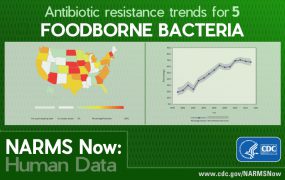The 2012 NARMS Human Isolates Report
CDC NARMS tracks antimicrobial resistance in Salmonella and other enteric (intestinal) bacteria that may cause mild or severe diarrhea or bloodstream infection. NARMS is an interagency partnership among the US Centers for Disease Control and Prevention (CDC), the US Food and Drug Administration (FDA), the US Department of Agriculture (USDA), and state and local health departments.

Bacterial foodborne infections are common and can be serious. In severe cases, the right antibiotic, also called antimicrobial agent, can be life-saving. NARMS is the only source of national information on antibiotic resistance in foodborne pathogens like Salmonella. Understanding trends in antibiotic resistance helps doctors to prescribe effective treatment and public health officials to investigate outbreaks faster.
The 2012 NARMS Annual Human Isolates Report [PDF – 88 pages, 1.48 MB] provides the most recent nationwide data and:
- Highlights antibiotic resistance changes in 2012 compared to 2003-2007 [PDF – 88 pages, 1.48 MB]
- Introduces a new method for interpreting Campylobacter data [PDF – 88 pages, 1.48 MB]
Key Trends in 2012
To determine trends, NARMS compared 2012 to the average percentage of resistance during the first five years (2003-2007) that it conducted nationwide surveillance. Some overall trends moved in the right direction; others were worth concern; still others were disturbing.



